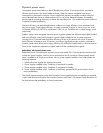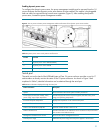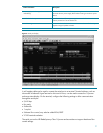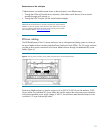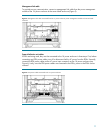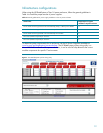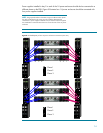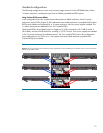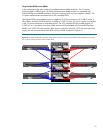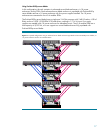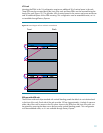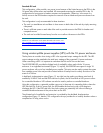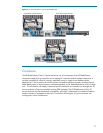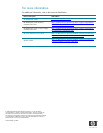
20
Standard 42U rack
This configuration, while possible, may cause issues because of the limited access to the PDUs in the
0U space after all the servers are installed. HP recommends mounting the modular PDU in the 1U
configuration for best access to breaker actuators and receptacles. Otherwise, in the event of a
failure, access to the PDU breakers requires the removal of server blade and power enclosures from
the rack.
This configuration is only recommended in these situations:
• The rack is a stand-alone unit and there is clear access to both sides of the rack by simply removing
side panels.
• There is sufficient space on each side of the rack to provide access to the PDUs for breaker and
receptacle access.
• The rack can be rolled forward away from the row to allow side access to the PDUs.
NOTE: For more information on the PDUs discussed in this section, visit:
http://h18004.www1.hp.com/products/servers/proliantstorage/power-
protection/power-distribution/index.html
Using uninterruptible power supplies (UPS) with the 1U power enclosure
The key factor to consider when sizing a UPS is the supported output wattage for the UPS. The UPS
output wattage must be matched to the total input wattage of the supported 1U power enclosure.
When connecting a UPS it is important to remember that VA and W are not the same.
The HP R5500XR UPS provides the highest level of availability when used with the 1U power
enclosure. In a single-feed environment (Figure 13, top left), the R5500XR can support a single 1U
power enclosure with up to four installed power supplies. This setup can be used to protect the system
from unstable power lines and provide a limited amount of backup time for orderly shut down in the
event of AC failure.
A dual-feed, single-protection setup (Figure 13, top right) can be used to provide an extra level of
availability. If the AC fails and the PDU side has no power, the full load shifts to UPS power to allow
for a controlled shutdown. UPS software can also be used to perform a controlled shutdown.
Using this configuration, a potential problem can occur in the event of a cascading failure where the
UPS side fails first. If the AC power fails, the UPS handles the load on its side, which begins to
discharge the UPS. If the PDU side fails, the whole system can potentially fail without initiating a
controlled shutdown because of the power drain on the UPS.
The ultimate level of availability and protection is provided by the dual-feed, dual-protection
configuration (Figure 13, bottom). This configuration always provides for an orderly shutdown when a
complete loss of utility power occurs.



